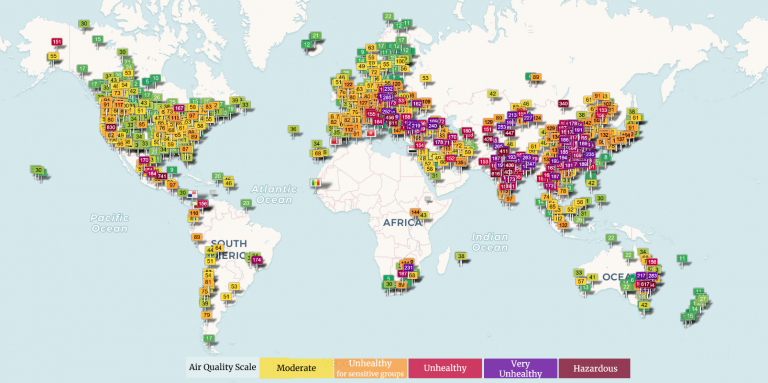Plastic’s Environmental Burden Covers Land, Sea, and Sky
Plastic has become synonymous with images of marine life strangled to death by plastic objects and billion-ton mountains of discarded plastic bottles. Although not as visible, plastic’s contamination of the air via toxic emissions have equally negative effects on the environment.
While real-time maps of air quality around the globe (below) demonstrate the severity of the air pollution crisis, creating moderate to hazardous air quality conditions, it is difficult to visualize the role that plastic plays. Recent research, however, provides insight into the material’s contributions to air pollution as well as its roots in the plastic industry.

New York Times bestselling author Seth M. Siegel is generally an advocate for business, who believes ethical commercial practice to be an ideal method of solving problems, Siegel is generally reluctant to condemn an entire industry. When it comes to plastic producers, however, he flags a range of serious risks to health, safety and the environment that they must address. His concerns include the industry’s profiteering from the process of extracting crude oil and natural gas (a process requiring toxic emissions) as well as the environmental and public safety threats posed by production of plastics such as PVC, which contains vinyl chloride; a chemical that has been linked to cancer.
A 2019 study of recent EPA reports on the rapidly expanding plastics industry in Houston, TX, exposed the environmental impacts that production of plastic has on air quality. Conducted by the Environmental Integrity Project, the review revealed that plants in the Houston area emitted 55,707 tons of pollutants over the course of a year. Over 60% of plastic and plastic ingredient manufacturing facilities had violated federal air pollutions limits over a five-year span; accounting for 22 percent of all industrial emissions in the region.
As it has been consistently reported by Safe Piping Matters, the impact of plastic on air quality remains after it is produced. It can be particularly deadly when it burns in commercial buildings, house fires, schools, hospitals and other facilities where its presence is widespread in construction and packaging materials, not to mention furnishings and fabrics. Plastic combustion releases toxic and carcinogenic chemicals that have been shown to elevate cancer risk among firefighters and other first responders exposed to the fumes. Exposure to such chemicals poses such a serious danger that the International Association of Fire Fighters proposed an all-out ban on plastic piping in building construction, demonstrating how seriously they consider this threat.
The respected environmental group rePurpose has created a profile of the ways in which the production and use of plastics have been found to affect air quality.
- Extracting Materials to Produce Plastic:
- Extracting and refining the petroleum-based components of plastic generates airborne emissions of toxic compounds such as benzene, toluene, ethylbenzene, xylene, carbon monoxide, and others. These chemicals appear in many types of plastics and Safe Piping Matters has extensively reported how plastic materials such as water pipes leach these same toxins into drinking water.
- Recycling Industry:
- For the fraction of plastic products that actually are recycled, many of them are shipped overseas to recycling facilities with poor pollution control; often being incinerated and emitting toxic contaminants into the air.
- Plastic and Garbage Incineration
- A large amount of the world’s garbage is burned, and as has mentioned above, when plastic is burned, the results are toxic.
- Microplastics:
- The production of plastic and its subsequent use has led to a global microplastics crisis. Plastic is non-degradable, and continues to break down into microscopic particles (known as microplastics) that present a number of threats to the environment and public health. Microplastics are so small that they are abundantly present in indoor and outdoor air and are susceptible to human inhalation.
Plastic is attacking our environment from all angles. As seen in Houston, the amount of harmful toxins being emitted into the air continues to grow in conjunction with the expanding plastic industry. In order to protect public health and the environment, increased research, awareness, and action need to happen in order to combat the airborne aspect of plastic pollution and contamination.
To learn more about the hazardous effects of plastic on the environment, browse our selection of relevant articles, blogs, news, and more.
